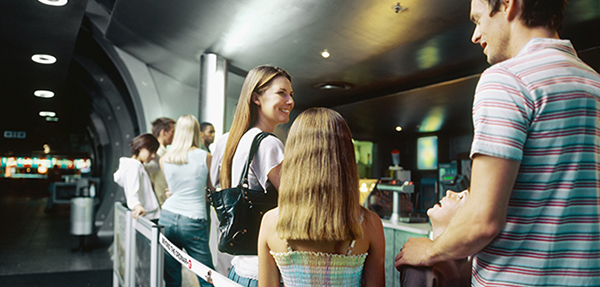
How Wait Times Impact Customer Behavior and Queue Management
Customers spend a significant amount of time waiting in lines. For instance, the average wait before being seated at a restaurant in the U.S. is 23 minutes, extending up to an hour at popular establishments.
Collectively, people in the U.S. spend an estimated 37 billion hours in line each year.
But just what effect does all this waiting around have on customer behaviors and attitudes? That was the central question that business school researchers Sezer Ulku, Chris Hydock, and Shiliang Cui investigated in 2018. They wanted to understand the relationship between wait times and subsequent purchase decisions. We wanted to know what the effects would be on queue management.
Their published report, “Making the Wait Worthwhile: Experiments on the Effect of Queueing on Consumption,” built upon previous queuing research. The new findings, however, turned some previously held beliefs about the impact of long wait lines upside down – and the resulting impacts on your queue management strategy might also surprise you.
Long Lines: A Tale of Two Outcomes
The researchers cited earlier studies that identified two important effects of long lines on organizational sales.
The first was a loss of sales due to customers who were off-put by long queues and didn’t stay to make a purchase. These customers reported leaving long lines due to the economic costs (i.e., lost time) or the psychological costs (e.g., frustration, boredom, anxiety) of sticking around.

Paradoxically, they also found long lines had the effect of attracting more customers because those lines were perceived as a sign of the “quality” of the products or services being delivered. Long lines increased the likelihood that other customers would join a line. Customers also inferred that products were “more valuable” if other people were behind them in line.
But while prior research yielded clear findings about queue impact on the number of customers served, the researchers wanted to investigate how time spent waiting in lines influences buying decisions.
For those customers who didn’t self-select out of waiting in line, what factors might shape their purchase behaviors?
All Wait Experiences Are Not Created Equal
Through a series of six controlled experiments, both lab-based and field-based, the three researchers tested several hypotheses by studying post-queue consumption patterns under different scenarios.
“Consumption” is an umbrella term used to capture quantity decisions, e.g., how much spent at a restaurant, how many items purchased.
Their findings were surprising.
1. The amount of time customers spend waiting in line results in increased consumption, provided they do not leave the line.
These researchers found that waiting in line for a longer period can cause customers to spend more. Researchers explain this phenomenon as “mental accounting for sunk costs.” In these cases, the larger purchase allows customers to mentally offset the ‘long wait suffered.’
Customers subconsciously assign a value to an item they’re purchasing relative to its price, referred to as acquisition utility, and the perceived value of the ‘deal,’ referred to as the transactional utility. In layman's terms, their thought process might go something like this: “I’m getting this $400 suit for an amazing price of $80, so it’s worth 20 extra minutes of my time waiting in line to purchase it.”
Conversely, a small purchase, which may be considered a ‘good deal’ for a customer in the absence of a wait would represent a ‘bad deal’ after a long wait. The perceived value of the deal can also be improved by spending more.
Case Study
Researcher Richard H. Thaler observed that people who paid for tickets for a baseball game in advance chose to drive despite a snowstorm, while those who got tickets for free preferred to say home.
In their research, David R. Just and Brian Wansink found people who paid a higher price at an all-you-can-eat restaurant ate more since more food for the same fixed price resulted in higher transaction utility, even though they enjoyed the food less.
So, while long lines negatively influence the actual number of customers served, these researchers surmised that those who remain mentally amortize the fixed and sunk costs of waiting in line by increasing consumption.
2. The benefits of improving the queuing experience resulted in a reduction in spending.
Another hypothesis examined in the study was whether different queue management or attention distraction strategies might alter purchase patterns.
Once again, the results were surprising.
They found that the benefits of improving the queuing experience, paradoxically, had a side effect of reduced spending. They reviewed the impact of placing reading materials, adding TV screens, or playing music to distract customers’ attention as they stood in line. They also examined a practice commonly employed at restaurants -- providing customers with a menu while they wait.
The three researchers found that these practices achieved their intended effect of reducing dissatisfaction due to long waits. However, they also resulted in lower actual consumption, suggesting that “higher customer satisfaction” is not always the same as “higher revenue.”
Case Study
Many restaurants attempt to improve the waiting experience by providing customers with a menu, either in-hand or that they can see from afar. Logically, managers would anticipate that providing a menu would improve order quantity as well as lead to better perceptions of service by distracting customers from an unpleasant wait. But as researchers David H. Maister and Richard C. Larson found, the provision of a menu led to lower individual sales. The presence of a menu lessened the psychological cost of waiting in line, and as a result, diminished the customers’ desire to spread this cost over a larger purchase quantity.
So, though customer satisfaction increases through initiatives that improve the queueing experience, their study revealed that in some cases, actual spending goes down.

It’s About Balance
The Making the Wait Worthwhile study is certainly eye-opening, but it begs the question, is the potential for increased individual sales stemming from long lines worth the risk of alienating other customers who will walk away? Should we rethink our entire approach to queue management?
Ultimately, it depends on your unique business and business strategy. While improving customer satisfaction might not always increase revenue from an immediate sale, over time it does create more loyal customers who would spend more over their lifetime. Businesses must weigh the cost of losing X amount of customers (potentially permanently!) from balking with the incremental profits from an uptick in sales from those customers who remain.
Queuing technology, digital signage, store fixtures… they can all play an important role in improving the wait experience and in keeping customers coming back. Additionally, the service and operational efficiencies created from implementing changes to the queuing process can decrease costs, ultimately increasing profits.
To learn how this and other research might impact your queuing strategy, reach out to a Lavi Industries professional.
SUBSCRIBE
Subscribe to stay up-to-date with new products, resources information and news.
RECENT RESOURCES
Theft at the Register: How Strategic Queue Design Protects Profits
ViewRapid Deployment Crowd Control: JetTrac Portable Barriers For The Biggest Spaces
View4 Psychological Reasons Your Customers Hate Waiting In Line
ViewFrom Bleachers To Bookstores: 4 Campus Crowd Control Solutions
View








